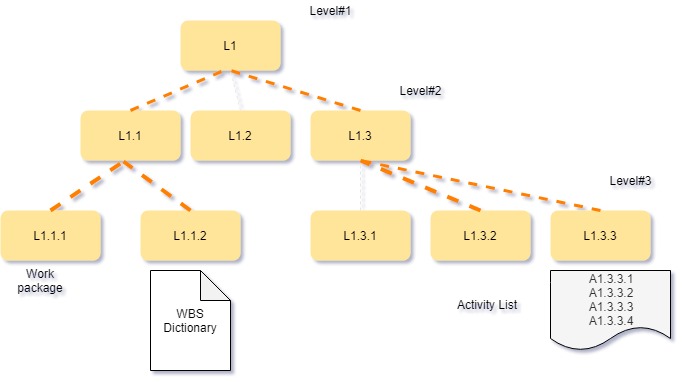Activity definition refers to decomposing the Work Packages (the lowest level elements in the WBS) activity lists
There are two levels of decomposition in projects;
- Decmposing the scope of the project into work packages
- Decomposing the work packages into activities
Decomposing work packages into activities is a crucial step in project planning, as it involves breaking down high-level deliverables into smaller, manageable tasks.

Here’s a structured approach to decomposing work packages into activities:
- Review Work Packages: Begin by reviewing the work packages identified in the Work Breakdown Structure (WBS). Each work package represents a discrete deliverable or component of the project.
- Identify Deliverables: Identify the specific deliverables or outputs associated with each work package. These deliverables should be tangible, measurable, and clearly defined.
- Brainstorm Activities: Engage stakeholders and subject matter experts to brainstorm the activities required to produce each deliverable. Consider all the tasks, steps, and actions necessary to complete the work package.
- Use a Structured Approach: Decompose work packages into activities.
- Document Activities: Document the decomposed activities into activity lists. Include details such as activity descriptions, durations, resource assignments, and dependencies.
- Validate with Stakeholders: Validate the decomposed activities with project stakeholders to ensure alignment with project objectives, requirements, and expectations. Address any feedback or concerns raised during the validation process.
- Refine and Finalize: Refine the list of activities as needed based on stakeholder feedback, changes in project scope, or new information that may emerge during the planning process. Finalize the list of activities before proceeding to the next phase of project planning.
By following this approach, project managers can effectively decompose work packages into activities that support the successful execution of the project and enable accurate scheduling, resource planning, and monitoring of progress.
Example
Let’s illustrate decomposing work packages into activities with examples from both Engineering, Procurement, and Construction (EPC) projects and Information Technology (IT) projects:
- EPC Project: Construction of a Power PlantWork Package: “Construction of Turbine Hall”Example Activities:
- Excavation and Site Preparation
- Foundation Construction
- Structural Steel Erection
- Installation of Turbines and Generators
- HVAC System Installation
- Electrical Wiring and Instrumentation
- Testing and Commissioning
- The work package “Construction of Turbine Hall” involves building the facility to house turbines and generators.
- Decomposing this work package into activities involves breaking down the construction process into smaller, manageable tasks such as excavation, foundation construction, steel erection, equipment installation, system installation, and testing.
- Each activity represents a specific task or action required to complete the work package, and they are sequenced logically to ensure efficient construction progress.
- IT Project: Development of a Mobile ApplicationWork Package: “Development of User Authentication Feature”Example Activities:
- Requirements Gathering for Authentication Feature
- UI/UX Design for Authentication Screens
- Backend Development for User Authentication Logic
- Integration with User Database
- Testing User Authentication Flows
- User Acceptance Testing with Stakeholders
- Deployment of Authentication Feature
- The work package “Development of User Authentication Feature” involves creating the functionality to authenticate users within the mobile application.
- Decomposing this work package into activities includes tasks such as gathering requirements, designing user interface screens, developing backend logic, integrating with databases, testing the authentication flows, conducting user acceptance testing, and deploying the feature.
- Each activity represents a distinct task or action necessary to implement the authentication feature, and they are sequenced logically to ensure the feature is developed efficiently and meets project requirements.
In both examples, decomposing work packages into activities allows project managers to break down complex deliverables into manageable tasks that can be scheduled, assigned, and monitored effectively. This decomposition process enables a more detailed understanding of the work required to complete the project and facilitates better planning, resource allocation, and progress tracking.
